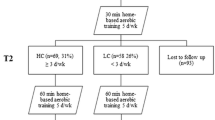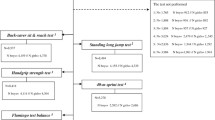Abstract
Background
Most studies on physical fitness and detraining have been conducted on normal-weight children. Their results indicate that any gains regress to the untrained control values during the detraining period. It, therefore, seems necessary to determine how detraining affects the different fitness parameters in obese children. The aim of the present study was to evaluate the effects of detraining (6 months) on kinanthropometry and the components of physical fitness after an intervention (31 months) consisting of a program of exercise and/or diet for obese boys.
Methods
The participants were 18 boys, aged between 8 and 11 years, divided into E and E+D groups according to the program they followed. The E group followed a physical exercise program (three 90-minute sessions/ week), and the E+D group the same physical exercise program plus a low calorie diet. Physical fitness was assessed by the European physical fitness test battery including flamingo balance, plate tapping, sit-andreach, standing broad jump, hand-grip strength, sit-ups, bent-arm hang, 10×5-metre shuttle run, and 20-metre endurance shuttle run. The Kruskal-Wallis test was applied to reveal overall intergroup differences (E and E+D groups), and measurements showing significant differences were further analysed for differences between individual groups by the Mann-Whitney U test.
Results
In both groups, changes were observed in various physical fitness parameters, especially limb speed (E group, P=0.001; E+D group, P=0.002), agility (E group, P<0.001; E+D group, P<0.001), and aerobic fitness (E group, P=0.009; E+D group, P=0.002).
Conclusion
Detraining after a long-term intervention based on the combination of exercise program and exercise program plus diet in obese boys does not affect the changes attained during the intervention.
Similar content being viewed by others
References
Han JC, Lawlor DA, Kimm SY. Childhood obesity. Lancet 2010;375:1737–1748.
Ebbeling CB, Pawlak DB, Ludwig DS. Childhood obesity: public-health crisis, common sense cure. Lancet 2002;360:473–482.
Lobstein T, Baur L, Uauy R; IASO International Obesity TaskForce. Obesity in children and young people: a crisis in public health. Obes Rev 2004;5Suppl 1:4–104.
Waters E, de Silva-Sanigorski A, Hall BJ, Brown T, Campbell KJ, Gao Y, et al. Interventions for preventing obesity in children. Cochrane Database Syst Rev 2011;12:CD001871.
Deforche B, Lefevre J, De Bourdeaudhuij I, Hills AP, Duquet W, Bouckaert J. Physical fitness and physical activity in obese and nonobese Flemish youth. Obes Res 2003;11:434–441.
Lopes VP, Stodden DF, Bianchi MM, Maia JA, Rodrigues LP. Correlation between BMI and motor coordination in children. J Sci Med Sport 2012;15:38–43.
Bouchard C, Shephard RJ, Stephens T. Physical activity, fitness, and health consensus statement. Champaign: Human Kinetics Publishers, 1993.
Mujika I, Padilla S. Detraining: loss of training-induced physiological and performance adaptations. Part I: short term insufficient training stimulus. Sports Med 2000;30:79–87.
Faigenbaum AD, Westcott WL, Micheli LJ, Outerbridge AR, Long CJ, LaRosa-Loud R, et al. The effects of strength training and detraining on children. J Strength Cond Res 1996;10:109–114.
Woo J, Shin KO, Yoo JH, Park S, Kang S. The effects of detraining on blood adipokines and antioxidant enzyme in Korean overweight children. Eur J Pediatr 2012;171:235–243.
Shalitin S, Ashkenazi-Hoffnung L, Yackobovitch-Gavan M, Nagelberg N, Karni Y, Hershkovitz E, et al. Effects of a twelveweek randomized intervention of exercise and/or diet on weight loss and weight maintenance, and other metabolic parameters in obese preadolescent children. Horm Res 2009;72:287–301.
Hernández M, Castellet J, Narvaiza JL, Rincón JM, Ruiz I, Sánchez E, et al. Curvas y tablas de crecimiento. Madrid: Garsi, 1988.
Sallis JF, Buono MJ, Roby JJ, Carlson D, Nelson JA. The Caltrac accelerometer as a physical activity monitor for schoolage children. Med Sci Sports Exerc 1990;22:698–703.
Maliszewski AF, Freedson PS, Ebbeling CJ, Crussemeyer J, Kastango KB. Validity of the Caltrac accelerometer in estimating energy expenditure and activity in children and adults. Pediatr Exerc Sci 1991;3:141–151.
Kumahara H, Schutz Y, Ayabe M, Yoshioka M, Yoshitake Y, Shindo M, et al. The use of uniaxial accelerometry for the assessment of physical-activity-related energy expenditure: a validation study against whole-body indirect calorimetry. Br J Nutr 2004;91:235–243.
Epstein LH, Myers MD, Raynor HA, Saelens BE. Treatment of pediatric obesity. Pediatrics 1998;101:554–570.
Golan M, Crow S. Targeting parents exclusively in the treatment of childhood obesity: long-term results. Obes Res 2004;12:357–361.
Mataix J, Garcia L. Nutriber. Madrid: Iberoamerican University Fundation, 2006.
Tanner JM, Whitehouse RH, Takaishi M. Standards from birth to maturity for height, weight, height velocity, and weight velocity: British children, 1965. I. Arch Dis Child 1966;41:454–471.
Norton K, Whittingham N, Carter L, Kerr D, Gore C, Marfell-Jones M. Measurement techniques in anthropometry. Adelaide: UNSW Press Book, 1996.
Council of Europe. Committe for the development of sport: European test of physical fitness. Handbook for the Eurofit Test of Physical Fitness. Roma: Coni, 1988.
Nevill AM, Atkinson G, Hughes MD, Cooper SM. Statistical methods for analysing discrete and categorical data recorded in performance analysis. J Sports Sci 2002;20:829–844.
Chang C, Liu W, Zhao X, Li S, Yu C. Effect of supervised exercise intervention on metabolic risk factors and physical fitness in Chinese obese children in early puberty. Obes Rev 2008;9Suppl 1:135–141.
Gutin B, Owens S. Role of exercise intervention in improving body fat distribution and risk profile in children. Am J Hum Biol 1999;11:237–247.
Watts K, Jones TW, Davis EA, Green D. Exercise training in obese children and adolescents: current concepts. Sports Med 2005;35:375–392.
Minck MR, Ruiter LM, Van Mechelen W, Kemper HC, Twisk JW. Physical fitness, body fatness, and physical activity: The Amsterdam Growth and Health Study. Am J Hum Biol 2000;12:593–599.
Bandini LG, Schoeller DA, Dietz WH. Energy expenditure in obese and nonobese adolescents. Pediatr Res 1990;27:198–203.
Malina RM, Bouchard C, Bar-Or O. Growth, maturation, and physical activity. Champaign: Human Kinetics Publishers, 2004.
Saavedra JM, Escalante Y, Garcia-Hermoso A. Improvement of aerobic fitness in obese children: a meta-analysis. Int J Pediatr Obes 2011;6:169–177.
Chae HW, Kwon YN, Rhie YJ, Kim HS, Kim YS, Paik IY, et al. Effects of a structured exercise program on insulin resistance, inflammatory markers and physical fitness in obese Korean children. J Pediatr Endocrinol Metab 2010;23:1065–1072.
Escalante Y, Saavedra JM, García-Hermoso A, Domínguez AM. Improvement of the lipid profile with exercise in obese children: a systematic review. Prev Med 2012;54:293–301.
Goran M, Fields DA, Hunter GR, Herd SL, Weinsier RL. Total body fat does not influence maximal aerobic capacity. Int J Obes (Lond) 2000;24:841–848.
Aires L, Silva P, Silva G, Santos MP, Ribeiro JC, Mota J. Intensity of physical activity, cardiorespiratory fitness, and body mass index in youth. J Phys Act Health 2010;7:54–59.
Author information
Authors and Affiliations
Corresponding author
Rights and permissions
About this article
Cite this article
García-Hermoso, A., Saavedra, J.M., Escalante, Y. et al. Effects of a long-term physical exercise program with and without diet on obese boys after six-month detraining. World J Pediatr 10, 38–45 (2014). https://doi.org/10.1007/s12519-014-0451-7
Received:
Accepted:
Published:
Issue Date:
DOI: https://doi.org/10.1007/s12519-014-0451-7




